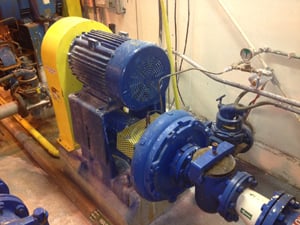
Slurry is one of the most challenging fluids to move. It's highly abrasive, thick, sometimes corrosive, and contains a high concentration of solids. No doubt about it, slurry is tough on pumps. But selecting the right centrifugal pump for these abrasive applications can make all the difference in the long-term performance.
Slurry is any mixture of fluid and fine solid particles. Examples of slurries would include: manure, cement, starch, or coal suspended in water. Slurries are used as a convenient way to handle solids in mining, steel processing, foundries, power generation, and most recently, the Frac Sand mining industry.
Slurries generally behave the same way as thick, viscous fluids, flowing under gravity, but also pumped as needed. Slurries are divided into two general categories: non-settling or settling.
Non-settling slurries consist of very fine particles, which give the illusion of increased apparent viscosity. These slurries usually have low wearing properties, but do require very careful consideration when selecting the right pump because they do not behave in the same manner as a normal liquid does.
Settling slurries are formed by coarse particles that tend to form an unstable mixture. Particular attention should be given to flow and power calculations when selecting a pump. The majority of slurry applications are made up of coarse particles and because of this, have higher wear properties.
Below are common characteristics of slurries:

Many types of pumps are used for pumping slurries, but the most common slurry pump is the centrifugal pump. The centrifugal slurry pump uses the centrifugal force generated by a rotating impeller to impact kinetic energy to the slurry, similar to how a water-like liquid would move through a standard centrifugal pump.
Slurry applications greatly reduce the expected wear life of pumping components. It’s critical that pumps designed for these heavy-duty applications are selected from the start. Consider the following when making selections:
To ensure the pump will hold up against abrasive wear, the impeller size/design, material of construction, and discharge configurations must be properly selected.
Open impellers are the most common on slurry pumps because they’re the least likely to clog. Closed impellers on the other hand are the most likely to clog and the most difficult to clean if they clog.
Slurry impellers are large and thick. This helps them operate longer in harsh slurry mixtures.
Slurry pumps are generally larger in size when compared to low-viscosity liquid pumps and usually require more horsepower to operate because they're less efficient. Bearings and shafts must be more rugged and rigid as well.
To protect the pump’s casing from abrasion, slurry pumps are oftentimes lined with metal or rubber. Goulds Pumps, for example, lines their XHD (Extra Heavy Duty) slurry pump with rubber.
Metal casings are composed of hard alloys. These casings are built to withstand the erosion caused by increased pressure and circulation.
The casings are selected to suit the needs of the application. For instance, pumps used in cement production handle fine particles at low pressures. Therefore, a light construction casing is acceptable. If the pump is handling rocks, the pump casing and impeller will need a thicker and stronger casing.

Those with experience pumping slurries know it's not an easy task. Slurries are heavy and difficult to pump. They cause excessive wear on pumps, their components, and are known to clog suction and discharge lines if not moving fast enough.
It’s a challenge to make slurry centrifugal pumps last for a reasonable amount of time. But, there are a few things you can do to extend the life of your slurry pump and make pumping slurry less of a challenge.
Pumping slurries poses several challenges and problems, but with proper engineering and equipment selection, you can experience many years of worry-free operation. It's important to work with a qualified engineer when selecting a slurry pump because slurries can wreak havoc on a pump if not properly selected.
Check out the Must-Have Handbook for Centrifugal Pumps for more information on centrifugal pumps, including details about pumps specifically designed for slurry applications!
Expert Centrifugal Pump Insights from Crane Engineering
Engineers and experts rely on Crane Engineering for insight and help with centrifugal pumps to pump slurry. Our in-house team of engineers can answer questions related to not only pumps but valves and skid systems. We provide a complete service and repair team who will fix pumps back to OEM standards. We are ready to assist you, contact us, today if you're in Wisconsin, Minnesota, Iowa, North Dakota, South Dakota, and the Upper Peninsula of Michigan. Crane Engineering also builds and designs customized skid systems nationwide.
Let us know how we can help you, request a quote today!
These Stories on Pumps
Headquarters and Service Center
Located outside Green Bay, WI
707 Ford Street
Kimberly, WI 54136
920-733-4425
OptiFlow Design and Build Center
1002 Truman Street
Kimberly, WI 54136
920-733-4425
Burnsville Service Center
12265 Nicollet Avenue
Burnsville, MN 55337
952-444-1949
Grand Rapids Service Center
26489 Industrial Blvd
Cohasset, MN 55721
952-444-1949
© Copyright 2024. Crane Engineering. All Rights Reserved. Privacy Policy.